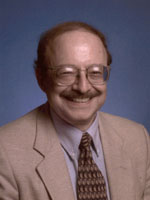
Edward I. Stiefel
Princeton University
Metals in Biology and its Progeny
In the early 1970s, as an assistant professor at the State University of New York at Stony Brook, I started attending both the Inorganic Chemistry Gordon Conference and the Metals in Biology (MIB) Conference. I had only a faint awareness of the diverse and critical roles that metal ions play in biological systems. Attending the MIB Conference convinced me of the area’s enormous potential, and I committed myself to the nascent field of bioinorganic chemistry.
Three specific results came from my early attendance at MIB. First I became aware of the ignorance about critically important molybdenum enzymes, such as nitrogenase, nitrate reductase, and xanthine oxidase, and decided to focus on this area of research. Second, on the request of Steve Lippard (then at Columbia University and editor of
Progress in Inorganic Chemistry) with whom I drove to the conference, I wrote a review called “The Bioinorganic and Coordination Chemistry of Molybdenum” that became a citation classic with over eight hundred citations. Third, an invitation to attend a seminar from Bill Newton of the Charles F. Research Kettering Laboratory, who I met on the tennis court during the MIB Conference, led to my joining the Nitrogen Fixation Mission at Kettering. Clearly, MIB had a tremendous influence on my early career and research.
In 1980, while still attending MIB, I moved to Exxon Corporate Research, and I persuaded the company to provide some support for MIB for many years. In 1993 I chaired MIB, and, as Doug Rees presented the first nitrogenase crystal structure, I realized how far the field had come but how much was still unknown. MIB continued to meet on a yearly basis in California, but there were always good-natured complaints that only one session, at most, was spent on a particular subfield. This opened the door to new Gordon Conferences, such as the Nitrogen Fixation Conference, chaired by Doug Rees and Bill Orme-Johnson, that first met in 1994 and at which I gave the opening talk, called “Chemistry of Nitrogen Fixation.” It was great to have a Gordon Conference focused on the molecular aspects of nitrogenase.
At the Nitrogen Fixation Conference I first realized that a GRC on other molybdenum enzymes would attract a large audience. A few years later Russ Hille, of Ohio State University, and I proposed a new Gordon Conference called Molybdenum and Tungsten Enzymes. Together we chaired the inaugural conference held in New Hampshire in 1999, with eighty attendees. Two years later one hundred attendees met at Oxford University. This specialized subject attracted bioinorganic chemists, crystallographers, biophysical chemists, molecular biologists, microbiologists, botanists, and physicians. The resulting cross-fertilization was remarkable, and the conference continues to meet on a two-year cycle.
In 1998 my group at Exxon joined researchers from Princeton University, Rutgers University, and the University of California campuses to form the Center for Environmental Bioinorganic Chemistry (CEBIC), directed by François Morel and funded by the National Science Foundation and the Department of Energy. Many interactions among CEBIC researchers were first forged at Gordon Conferences. CEBIC was such a wonderful experience that in 2001 I moved to Princeton University with appointments in the chemistry department and the Princeton Environmental Institute (which houses CEBIC). At Princeton I have been fortunate to teach a freshman seminar called Elements of Life, which has convinced me that bioinorganic chemistry is a splendid vehicle for teaching chemistry and its relation to biology, geology, astrobiology, and environmental science. Meanwhile, CEBIC continued to thrive, and each year our summer workshop at Princeton drew more people from outside CEBIC. This success led François Morel and me to propose the Environmental Bioinorganic Chemistry (EBIC) Gordon Conference, and in 2002 François and I chaired its inaugural conference, with 125 attendees from a remarkable range of disciplines. The conference now meets regularly on a two-year cycle.
Meanwhile MIB is thriving, despite the heavy attendance draw (one thousand participants) of the International Conference on Biological Inorganic Chemistry. Without losing momentum, MIB continues to spawn new conferences such as the 2002 Metals in Medicine (chaired by Nick Farrell) and the 2005 Cell Biology of Metals (chaired by Nigel Robinson and Dennis Winge). MIB is far from finished as it continues to stimulate interdisciplinary cross-fertilization of ideas in an intimate setting with a wonderfully paced program that only GRC can provide.